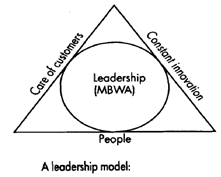Management Or Leadership - What Is The Difference
Introduction:
Management and leadership tend to complement one another. Strong leadership with weak management is no better than strong management with weak leadership. Similarly to leadership, there are various management styles which can be adopted by organisations, most of them can be effective in some respects and perhaps reflect weaknesses in other areas. Effective management therefore is the best approach to combine management with leadership.
Difference:
'Leadership is different from management, but not for reasons most people think. Leadership isn't mystical or mysterious. It has nothing to do with having "charisma" or other exotic personality traits. It is not the province of a chosen few. Nor is leadership necessarily better than management or a replacement of it. Rather, leadership and management are two distinctive and complementary systems of action.’
A leadership model: 
Figure represents a model where the continued effort to delight customers has to be matched by the constant need to innovate, using people as the best means. The whole effect is instigated, managed, coordinated and controlled by a leadership style which is informal and values the human creative potential.
A comparison of management and leadership roles:
|
Management |
leadership |
|
Coping with complexity |
Coping with change |
|
Involves deciding what needs to be done, creating networks of people and relationships that can accomplish an agenda |
Involves deciding what needs to be done, creating networks of people and relationships that can accomplish an agenda |
|
Manage complexity first by planning and budgeting setting targets or goals for the future – establishing steps for achieving those targets - allocating resources to accomplish those plans |
leading an organisation to constructive change begins by setting a direction- developing a vision of the future along with strategies for producing the changes needed to achieve the vision |
|
Achieve plans by organizing and staffing- creating an organisational structure and tasks, staffing the jobs with able people, communicating all plans, delegating responsibility and devising systems to monitor the implementation of various plans |
Achieve plans by aligning people communicating the new direction to people who understand the vision and are committed to its achievement |
|
Ensures plan accomplishment by controlling and problem-solving monitoring results compared with set plans - identifying deviations and solving problems |
Achieving a mission requires motivating and inspiring - keeping people in the right direction by appealing to basic human potential often untapped |
- There is a high degree of compatibility between the role of management and leadership.
- Organisations which are striving for excellence and superior performance have to narrow the gap between the roles of managers and leaders and make sure that they are the same.
- After all being an effective leader requires internal operations to be managed efficiently.